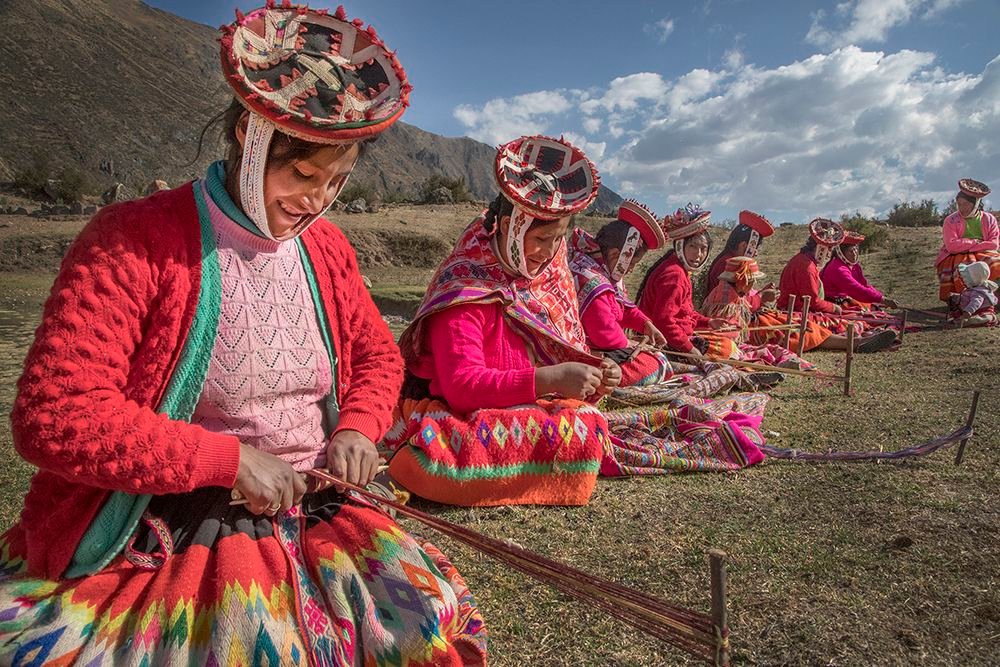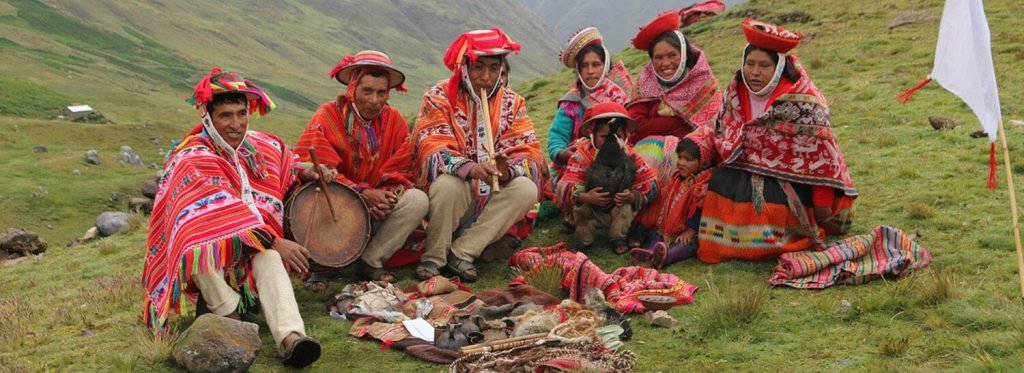Town of Patacancha
The village of Patacancha is located at a distance of 88 km from the city of Cusco, approximately 2 hours by car, within the district of Ollantaytambo, where it is not uncommon to meet locals.
Along with the inhabitants of Willoq, they are an ethnic group that has kept Inca traditions alive. Going to meet them is an essential experience to get closer to the traditional Andean lifestyle, rich in ancestral traditions and South American culture.
Culturally recognized for their iconic works of textile art, they are a true heritage treasure. Their expressions can be seen in their own clothing which can be identified by the striking red and black colors. The register is wide (covers or lliclla, ponchos, shawls, bags…), and the visitor can find in these jewels pieces of great quality with a smell of the authentic, more than the products that are sold in some chains and handicraft markets of Cusco or Lima.

The textile art in Patacancha is a tradition that is transmitted from mothers to daughters and from generation to generation. As for the colors, they extract their ink from local plants, and each motif that comes to life on the artist’s loom has a symbolic meaning that has been maintained for centuries and even millennia (the oldest textiles discovered in Peru at Huaca Prieta are more than 6000 years old) and whose iconographic origin of the bestiary and geometric shapes used finds its filiation in the cave paintings of the subcontinent, strongly imbued with shamanism and its connection with its deities and nature.
Location
The town of Patacancha is 88 km (2 hours) from Cusco by paved road. It is located in the province of Urubamba, Cusco, which belongs to Ollantaytambo. Within the flora and fauna there are 60 species of birds, and more than 700 species of plants. It is also known for being the starting point for the hike to Lares. Community known for its high quality textile colors and traditional way of life.
Altitude of Patacancha in Peru
The altitude of Patacancha in Peru is 4,666 meters above sea level.
Community-based tourism in the town of Patacancha

The Patacancha valley in Peru is a very particular ethnic group according to some writers who maintain a direct line from the last Incas, which is corroborated by their surnames such as Sinchi, Pukha, Cusipaucar, Tupha and others.
Patacancha is located near the town of Ollatantaymbo, this place is one of the most privileged places to learn about the Andean Tradition, the people of Willoq and Patacancha meet with visitors as a way to integrate into a society that respects them as equals, which is why it is not surprising that they are scattered throughout the square, and the streets of the town of Ollatanytambo.
Patacancha is a place widely recognized as a starting point to connect with experiential tourism, this iconic place is a fully recommended destination for those travelers seeking an additional connection with the Inca culture and its last descendants. Many times it has been seen how travelers arrived at the main destination in the area, Ollantaytambo, spent a few hours in it and then retired in their buses, without having had the opportunity to know a real heritage treasure (the weaving) handmade and the way they manage to do it, on the one hand, and on the other hand, excluding communities dedicated to the manufacture of textile art, definitely a very enriching destination for visitors.
Living Culture in the Patacancha Valley

The villagers then began to make known, first of all, that their textiles and their culture in general has a great value that should be recovered to put it in sight of the lovers of culture and, at the same time, open to the world of tourism where day by day the interaction with the living culture is becoming more popular.
Travelers who know how to appreciate the quality of popular art visit these communities because they know that there they will find pieces of excellent workmanship, very different from the massive product that is exhibited in the markets of the cities of Cusco.
In addition, in the Patacancha valley, in Peru, you can meet villagers who have become aware of the value of the traditions of their people and are willing to share them, with great cordiality and joy characteristic of the Peruvian Andean culture, in scenarios that combine a mountainous nature of exceptional beauty, with architectural elements such as terraces and houses built with adobe and roofed with tile or ichu.
When you are close to the village, you can feel a different atmosphere from the city because there you can breathe pure air of nature, the human presence adds to the intensity of red and black that dominate the traditional dress. For this reason, the common name given to these descendants of the Incas, “Huayruros” because their clothing highlights to the eye the color of the seed of good luck.
Costumes

The costumes are very beautiful and very colorful, their ponchos woven in different earth tones, chullos decorated with beads and buttons, embroidered monteras, ribbons, braids, hands.
The men fulfill similar roles and most of them are porters of the Inca Trail to Machu Picchu, and many of them complete their working hours in this way, these men are of strong character and very well fed thanks to the green leaf of the coca tree that makes their build resist the hard work of being a porter.
Every day of the week, the local weavers are active, but should be visited preferably on Saturdays, which is when they have prepared to receive travelers, where they can share ideas and customs.
In Patacancha there is also an association of weavers, women who on average only speak Quechua and who, like their neighbors, weave wonders such as llicllas, shawls, ponchos, bags, blankets, of a fineness that the natural fiber (sheep or alpaca) can give the texture of silk to all their textile fabrics.
It is also very important to know that the inputs to give color and life to their fabrics are obtained from local plants that provide the iconic and unmistakable colors for their crafts, their designs in each craft have a unique meaning in itself.
Cusco has another option for experiential tourism, Raqchi, which is another alternative for its experiential tourism and cultural interaction.
Patamarca and its inhabitants are waiting for your visit, do not forget to acquire one of the jewels of its textile art, more than a souvenir is an element that represents the work of several generations as the cultural expressions of the last Inca descendants that inhabit the city of Cusco.





